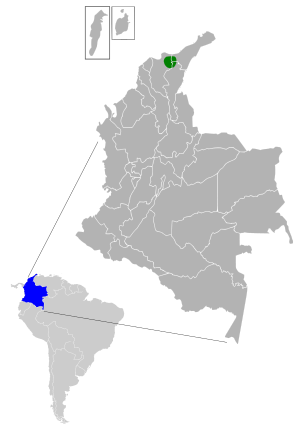White-tailed starfrontlet facts for kids
Quick facts for kids White-tailed starfrontlet |
|
|---|---|
 |
|
| Conservation status | |
| Scientific classification | |
| Genus: |
Coeligena
|
| Species: |
phalerata
|
 |
|
| Synonyms | |
|
Leucuria phalerata |
|
The white-tailed starfrontlet (Coeligena phalerata) is a species of hummingbird in the "brilliants", tribe Heliantheini in subfamily Lesbiinae. It is endemic to the Sierra Nevada de Santa Marta of northeastern Colombia.
Contents
Taxonomy and systematics
The white-tailed starfrontlet and most other members of genus Coeligena were at one time placed in genus Helianthea but have been in their current placement since the mid-1900s. The species is monotypic.
Description
The white-tailed starfrontlet is about 14 cm (5.5 in) long. Both sexes have a long, straight, black bill, with the female's being somewhat longer than the male's. Both sexes have a white spot behind the eye. Both sexes also have a forked tail, but the male's is more deeply indented than the female's. Adult males have metallic dark green upperparts with a glittering turquoise crown. The entire tail is white, though the feathers when fresh have bronze tips. They have a blue gorget, mostly emerald green underparts, white leg puffs, and white undertail coverts. Adult females have a dusky blue-green crown and shining green upperparts. The tail is bronzy with pale buff tips to the feathers. Its underparts are rufous cinnamon. Immatures are similar to the adult female.
Distribution and habitat
The white-tailed starfrontlet is found only in northeast Colombia's isolated Sierra Nevada de Santa Marta. It inhabits humid to wet montane forest; males prefer openings within the forest while females are more often seen at the forest edge. In elevation it ranges between 1,400 and 3,700 m (4,600 and 12,100 ft).
Behavior
Movement
Nothing is known about the white-tailed starfrontlet's movements, if any.
Feeding
The white-tailed starfrontlet feeds on nectar. Sources are known to include Fuchsia and bromeliads, though it probably feeds on a wide variety of plants like others of its genus. It is more territorial than other Coeligena but also sometimes feeds by trap-lining. In addition to feeding on nectar it captures small arthropods by gleaning from foliage and by hawking.
Breeding
The white-tailed starfrontlet's breeding season appears to span from February to April, but nothing else is known about its breeding phenology.
Vocalization
Only a few white-tailed starfrontlet vocalizations have been recorded. It is known to make "a high-pitched chattering 'tsee-tsee-tsi-tsi-tsirrrrr' and lower-pitched short rattles."
Status
The IUCN originally assessed the white-tailed starfrontlet as being of Least Concern but since 2018 has rated it as Near Threatened. It has a very small range "where it is under threat of habitat loss and fragmentation". Its population size is not known and is believed to be decreasing.
See also
 In Spanish: Coeligena phalerata para niños
In Spanish: Coeligena phalerata para niños



